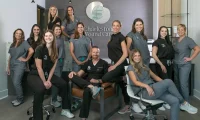It’s no secret that technology is racing ahead of us, with new innovations seemingly emerging daily. Applications for the health care industry are particularly exciting. Whether improving early diagnoses, reducing the risk of infection, permitting more precise surgeries or decreasing hospital stays and recovery times, these new innovations benefit the patients using them and the doctors delivering the services. Here’s a brief look at three new procedures and a sample of South Carolina facilities that offer them.
(1) According to Savannah Coker, O.D., of The Vision Center at Seaside Farms, “The retinal imaging screener we now use in our annual eye health examinations creates a wide-field photograph of the retina as well as a valuable cross-sectional scan. These eye health scans can now take less than 10 minutes and avoid the use of annoying dilation eyedrops. Beginning changes can be detected that might not be caught by a typical eye examination. This information has allowed us to catch early signs of macular degeneration, glaucoma, hypertension, diabetes and many other eye diseases.”
Other new vision technology includes Neurolens, an eyeglass lens that can reduce symptoms such as headaches, neck pain, shoulder pain and eye strain. Intense pulsed light therapy and the TearCare system offer improved dry-eye treatments. Recently, eye vitamins that can reduce the size of floaters and eyedrops that can improve focus and reduce the need for reading glasses have been introduced to the market.
Dr. Coker is a fan of both new technologies: “I have always loved the community aspect of private practice in optometry, and that is what drew me to The Vision Center at Seaside Farms. Today’s new technology allows me to give exceptional care to my patients.”
(2) Coastal Vascular & Vein Center has five locations in the Charleston area. The introduction of Medtronic’s Ellipsys has been a game-changer for its dialysis patients experiencing end-stage renal disease. Brian Driscoll, the senior marketing director for peripheral vascular health, the company that owns this technology, explained: “Using a single catheter and a one-poke application, this device allows doctors to use thermal energy to fuse a connecting and very durable portal between the vein and the artery needed for kidney dialysis. Unlike traditional fistulas, which must be surgically created in a hospital, the Ellipsys requires no incision and can be done in a 15- to 20-minute procedure in an outpatient clinic.”
Driscoll continued, “In a clinical study, Medtronic found a 97% patient satisfaction rate with use of the Ellipsys device. While doctors will need some specialized training – which can be accomplished online or through in-person training sessions at Medtronic – using the Ellipsys device for AV fistula creation allows patients to return home the same day and limits access-point scarring. Studies have also found that the Ellipsys fistula is likely to last longer than a traditional surgical fistula.”
The Ellipsys system was approved by the Food and Drug Administration in 2018 and has become a valuable asset at Coastal Vascular & Vein Center.
Sean Hislop, M.D., chief of the department of Vascular Surgery and a vascular surgeon at Coastal Vascular & Vein Center, agreed: “The Ellipsys procedure has allowed our dialysis patients to have easy access to care and to avoid all of the hassles of the hospital. In addition, this procedure has a higher success rate than a traditional surgical fistula, making it easier and safer to prepare a patient for dialysis. Both first-time dialysis patients and patients currently on dialysis are candidates for this advanced minimally invasive procedure.”
(3) Paul LaPenna, D.O., is a neuro-hospitalist at Bon Secours St. Francis Hospital in Greenville. When a patient is experiencing a stroke, time is of the essence. Recent artificial intelligence technological advances speed up brain mapping to pinpoint where damage is occurring.
“I can literally read the scans on my phone while I am on my way to the hospital or coming down to the floor from another location in the hospital,” said Dr. LaPenna. “This feature speeds up ischemic stroke detection and can predict outcomes. It reduces the time needed to gather data for urgent decision-making such as which treatments to include or exclude, how to identify which parts of the brain will be irreparably damaged if not treated and whether or not the timing is right to remove the offending clot. Furthermore, showing family members pictures of the scan helps to explain the situation better to them.”
As wonderful as this new artificial intelligence capability is for stroke victims and their doctors, “AI will still always need a neurologist who is aware of the patient’s history and other medical conditions, and doctors will need some specialized training to use it properly,” cautioned Dr. LaPenna.
For Bon Secours stroke patients, this new technology can help physicians intervene quickly with the hope of improving recovery outcomes and, consequently, their patients’ quality of life.
Whether health care technology is addressing vision deterioration, renal failure, heart disease or a host of other physical ailments, such advancements are significantly improving treatment for patients with these challenges – and for them, their families and their doctors, improved health care delivery is certainly cause for celebration.
By Janet E. Perrigo







